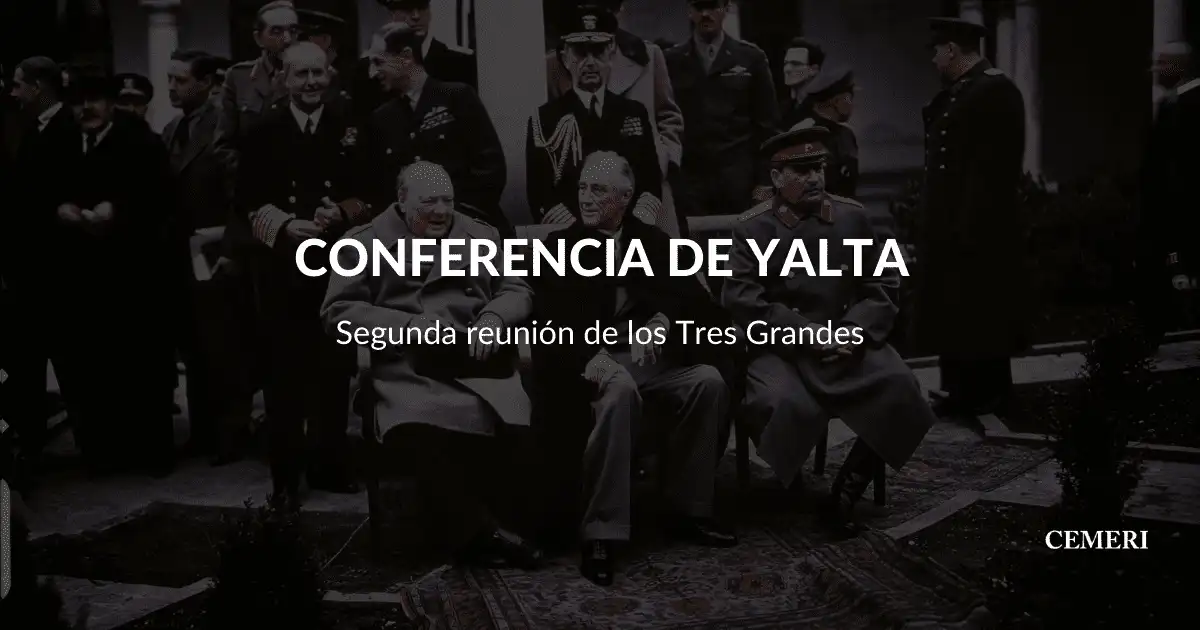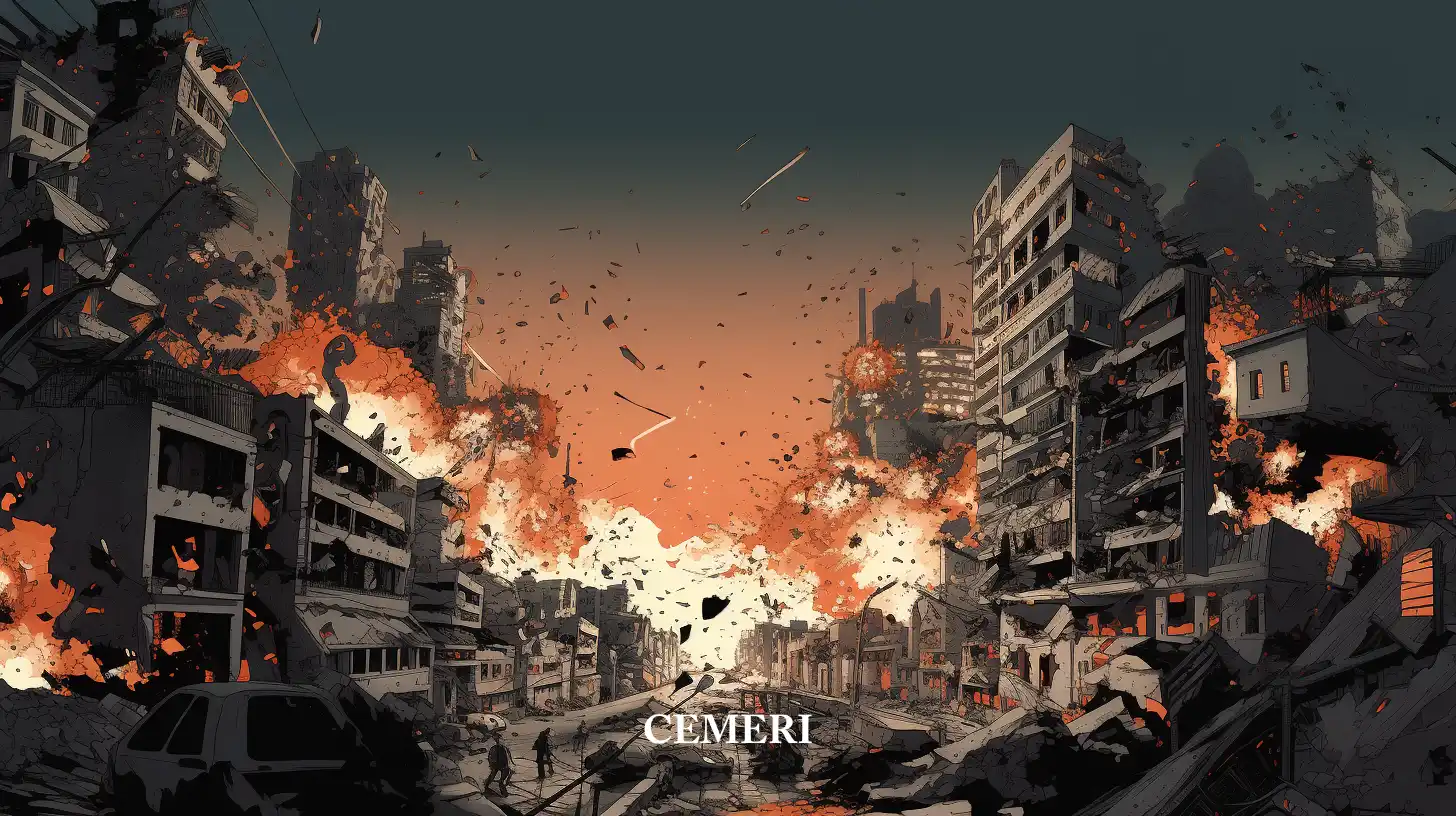Encyclopedia
Marco Olivera
What is the Yalta Conference?
- The Yalta Conference was the second of three conferences held during World War II between the leaders of the Big Three.

The Yalta Conference, also known as the Crimean Conference (and codenamed Operation Argonaut), took place between February 4 and 11, 1945. US President Franklin D. Roosevelt, British Prime Minister Winston Churchill and Soviet Premier Joseph Stalin met in Yalta, a city on the southern coast of the Crimean peninsula on the Black Sea. Its goal was to discuss how to end World War II and plan for the postwar reorganization of Europe, in particular the defeat and occupation of Germany.
The Yalta Conference was the second of three major conferences held during World War II between the leaders of the Big Three. It came after the Tehran Conference in November 1943. It was to be followed by the Potsdam Conference in July 1945.
During the Yalta Conference, certain key decisions had to be made, especially regarding the fate of post-war Germany and Poland, the fate of cities such as Lviv/Lwow and Koningsberg/Kaliningrad, as well as the defeat of the Japanese. In the pacific. Two other important results of the conference were the agreement between the leaders to create the United Nations, as well as allowing all countries liberated from Nazi control to choose their own governments through free elections.
The events of the Yalta Conference laid the foundation in many ways for the rest of the Cold War in Europe. For example, a large part of the German capital, Berlin, was located within the Soviet zone of Germany. However, according to the conference agreements, Berlin was also divided into four zones, so that the Western Allies could station troops behind the Iron Curtain. Because of this, Berlin became a source of tension during the Cold War.
Why Yalta?
Holding the Conference in Yalta intentionally demonstrated a shift in the axis of world power for Stalin. Claiming that his health would not allow him to travel by plane, the Soviet leader insisted on meeting at the Black Sea. So the ailing US President Roosevelt, who had suggested that the meeting be held somewhere in the Mediterranean, had to make an arduous journey of more than 9,500 km; Churchill, over 70 years old, 6,400 km. After meeting in Malta on February 2, Roosevelt and Churchill flew 2,250 kilometers to the Crimea, followed by an eight-hour drive. While Stalin took a train to Yalta from Moscow.
The so-called big three met for eight days in former imperial palaces on the beautiful Black Sea coast of Crimea, which was still in shambles from war and German occupation. Among these palaces was the Livadia Palace, the former summer residence of Tsar Nicholas II. By early 1945, Germany, Stalin thought, had finished as a world power and the USSR was on the verge of becoming one, on the basis of its outstanding military contribution: the extraordinary sacrifice and success of the Red Army had now given it the Time to take advantage of it. In addition, he deliberately chose the Crimea as a place for his guests to witness the destruction that the Germans had left there.
At the end of the Conference, most of Stalin's concessions were granted to him.
Winston Churchill and Franklin D. Roosevelt during the Yalta Conference.
Photo: Ralph Graham
What was going on in 1945?
The Yalta Conference took place at a critical time in World War II. 1944 had been a breakthrough year, with the Normandy landings in June and the great Russian summer offensive in the east. Stalin, despite the terrible losses suffered by the Soviet forces, held a commanding military position. In early 1945, the Eastern Front stretched from Memel in the Baltic through Poland and Czechoslovakia to Yugoslavia. The Red Army was on the Oder, barely 40 miles from Berlin.
It was clear that, despite continued resistance, Germany's defeat was close, although Japan's was not. The Battle of the Bulge, the last German offensive on the Western Front, fought in the Ardennes region of Belgium, had shattered what was left of the German army, as well as destroying weapons, tanks, and essential supplies. Also, the allies had liberated all of France and Belgium and were threatening Germany's western border.
The once mighty Luftwaffe was drastically reduced, while Allied bombs continued to rain down on German towns and cities on a daily basis. Adolf Hitler's Third Reich was fighting a losing battle.
In early 1945, the Big Three recognized the pressing need to come to an agreement on how the war in Europe and the Far East would end, and also on what peace would look like. But their priorities were different and didn't necessarily coincide.
What did each of the 'big three' want from the meeting?
The three leaders had met 15 months earlier in the Iranian capital Tehran, where they discussed ways to defeat Nazi Germany, agreed to an invasion of Normandy and had talks about Soviet entry into the Pacific War. The tentative beginnings of what could be a future peace agreement were made in Tehran, but it was in Yalta that the real discussions began.
At Yalta, Stalin's priorities were to protect the borders of the enlarged Soviet state, win back his country, and be accepted as a superpower. He was deeply suspicious of the territorial, political, and commercial ambitions of his fellow allies. Intelligence he received from Soviet spies in official American and British circles increased that suspicion. The Soviet Union, while crushing German forces on the Eastern Front, had been devastated by the war, with an estimated 27 million Soviet citizens (about one in seven) killed during the conflict, and vast swaths of industry, agriculture, cities and homes destroyed.
He urgently needed to replenish his resources, human and material, exhausted by his superhuman efforts in the armed struggle. Thus he lobbied for huge reparations from Germany; as well as spheres of influence in Eastern Europe or Eastern Europe to prevent further invasions and ensure that Germany could never again threaten world peace.
The Soviet Union also had borders in the Pacific, so the outcome of the war with Japan mattered. Stalin did not want a post-war world ruled by the old imperialist power, the United Kingdom, or the new military and economic superpower, the United States. His was both a defensive and an offensive position.
United States – Franklin D. Roosevelt
Roosevelt was a sick man and he died two months after Yalta. However, his main priority was to secure the Soviet Union's entry into the war against Japan. American military advisers warned that victory could take another 18 months, and at this stage it was not certain that the atomic bomb would work or that it would force the Japanese into submission. Roosevelt needed Soviet help to defeat Japan and was willing to pay for it by conceding to Stalin's demands, whether it was independent UN membership for the Ukrainian and Byelorussian Soviet republics, a veto system in the Security Council, or the concession of the Island of Sakhalin, independently of other regional powers such as China.
Roosevelt wanted final victory over Germany, of course, but he could afford to wait a while if necessary. After the war, he envisioned only short-term American involvement in Europe and was more interested in formulating general principles than delving into individual country-by-country details. The United Nations was, likewise, a project that guaranteed a peaceful environment that would allow the withdrawal of the United States.
However, the participation of the United States on the world stage would be reconsidered just two years later with the Truman Doctrine.
World War II had given the United States global military and economic dominance. That is why it is thought that it was Roosevelt who was in the real position of power at Yalta. Although he valued the Anglo-American relationship, he was quite prepared to overlook British interests and instead attached great importance to the Soviet Union. Although, in reality, he was determined that American interests prevail.
UK – Winston Churchill
Churchill was well aware of the dangers that Yalta represented for British interests, for the future peace of Europe and the rest of the world. He was anxious to see an end to any future German threat, but worried that inflicting huge reparations on Germany, as had been done after World War I with the Treaty of Versailles, might, in the future, create a similar economic situation. in the country that had led to the rise and acceptance of the Nazi Party. Above all, he needed hostilities to end quickly: the burden of fighting a long war, from 1939 to 1941 alone, had crippled Britain financially. US support and assistance would be essential, as would a significant US commitment to European defense.
At Yalta, Churchill was frustrated that he saw Roosevelt's lack of understanding of the UK's global commitments, and of the perceived threat of Soviet dominance in Eastern Europe, but in the end his only weapon was persuasion. Although Churchill found it difficult to accept, the UK had little influence at Yalta and needed to concentrate on moderating, rather than dictating outcomes.
Concerning the division and occupation zones in Germany, Churchill wanted France to be invited to occupy a zone and to participate in the Control Commission, as Roosevelt was determined to restrict the time American troops remained in Europe. Less specific, but important, was Churchill's tough stance in defense of freedom and the rule of law in Europe.
Why was French leader Charles de Gaulle not present at the conference?
De Gaulle, by unanimous consent of the three leaders, was not invited to Yalta or the Potsdam Conference a few months later; it was a diplomatic slight that created deep and lasting resentment. Stalin, in particular, felt that decisions about the future of Europe should be made by those powers that had sacrificed the most in the war. If France were allowed to participate in Yalta, arguably other countries would have had the same right to attend as well.
Decisions of the Yalta Conference
The allies wanted to ensure a postwar peace, representing security and collective order within the European continent. In addition, certain key decisions had to be made, especially regarding the fate of postwar Germany and Poland, as well as the defeat of the Japanese in the Pacific.
Postwar Germany
First, the Allies decided that a "German Dismemberment Committee" should be established to decide how Germany should be divided. Stalin had originally demanded the complete dismemberment of Germany into mini-states and pay ruinous reparations, as he had done in 1919. Winston Churchill wanted to divide Germany into three different German states, while Roosevelt wanted a Germany made up of five regions, two international zones, and one Allied administered Austria.
The Morgenthau Plan, proposed in 1944 by Henry Morgenthau Jr., on the other hand, aimed to eliminate Germany's ability to wage war by getting rid of its arms industry and eliminating other industries key to military force. This included the destruction of all industrial plants located in the Ruhr valley.
In the end, the three leaders ratified the agreement of the European Advisory Commission. This divided Germany into three occupation zones, one each for the three main Allies, the United States, the United Kingdom, and the Soviet Union.
The Americans and British later agreed to give France her own zone of occupation, separate from theirs. Berlin, the capital of Germany, was similarly divided into four zones. Poland also annexed a large part of East Germany to make up for the land Poland lost to the Soviets.
The Allies also decided that they had to be prepared against a possible renewed military threat from Germany once the war was over. To achieve this, the denazification of Germany had to be complete. This operation was dubbed the Five Ds, which included the demilitarization, denazification, decentralization, democratization, and decartelization of Germany.
The fate of Poland
The fate of Poland was the most important issue for the Soviets. The Red Army fully occupied Poland when the meeting took place and controlled much of Eastern Europe, with military forces far larger than the Allies in the west.
Stalin claimed that the question of Poland was one of security, as Poland had historically served as a buffer zone or buffer state for forces attempting to attack Russia. This meant that Stalin wanted a strong Poland and expressed the desire of the Soviet Union to create a strong, free and independent Poland.
It was agreed at the conference that the Soviets could keep the eastern Polish territory they had annexed in 1939, while Poland would receive a large part of East Germany as compensation.
However, Stalin also wanted to install a communist government in Poland, while Roosevelt and Churchill believed that the London-based Polish government-in-exile was the most representative of the Polish people. In the end, the three leaders simply agreed that free elections should be held as soon as possible.
Japan and the end of the Pacific War
For Roosevelt, ending the Pacific War with Japan was of paramount importance, but to do so he needed Stalin's military help. The American president hoped this would end the war sooner and save American lives.
The Soviet Union agreed to break the Neutrality Pact with the Japanese and, that same year, carried out Operation August Storm or the Battle of Manchuria, an invasion of the Japanese puppet state of Manchuko (Manchuria).
However, Stalin made multiple demands before agreeing to the Soviets declaring war on Japan:
Mongolia's independence from China had to be officially recognized by the United States. This is because the Mongolian People's Republic had been a Soviet satellite state since 1924. The Soviets wanted their interests in the Manchurian and Port Arthur railways recognized without asking the Chinese to lease them.
The Soviets wanted the return of Karafuto, commonly known as Sakhalin Island, which they had lost during the Russo-Japanese War in 1905, as well as possession of the Kuril Islands.
Declaration of Europe released
The Big Three created the Declaration of Liberated Europe during the Yalta Conference. It was a promise that guaranteed to all countries liberated from Nazi control the right to create democratic institutions of their own choosing. The declaration promised that nations would be able to hold free elections and choose their own governments. These declarations were similar to those in the Atlantic Charter which declared “the right of all people to choose the form of government under which they will live”.
The Big Three agreed that all original governments should be restored to the invaded countries while awaiting new elections. However, Stalin was offered his own sphere of influence over Eastern Europe, where communist ideals would be upheld, as the Soviets had already installed their own governments in countries like Romania and Bulgaria. As for Poland, as already mentioned, its government in exile was totally excluded by Stalin and a new government would be elected.
United Nations
Finally, there was the United Nations, Roosevelt's number one priority. The Allies also agreed to the creation of this organization, with the aim of preventing future wars, succeeding the League of Nations which was ineffective in stopping the escalations that led to World War II.
The goal was to ensure international cooperation, and Roosevelt made sure to obtain a commitment from Stalin to participate in the United Nations during the Yalta Conference. Perhaps because Stalin underestimated the importance of the UN, he too let the Americans decide its basic structure.
The UN Charter was drafted and adopted by 50 governments when they met at the San Francisco Conference on April 25, 1945. The charter came into effect on October 24, 1945, when the UN began operations. There are now 193 members, representing almost every sovereign state in the world.
Was the Yalta Conference a success?
None of the Big Three left Yalta with all they had set out to achieve, but a public display of unity and cooperation was widely reported as they went their separate ways. At the end of the conference, it was agreed that they would meet once more after Germany surrendered, so that they could make firm decisions on any pending issues, including the borders of post-war Europe. This final meeting took place in Potsdam, near Berlin, between July 17 and August 2, 1945.
On the surface, the Yalta Conference seemed a success as the Allies were able to agree on a number of issues, leading to the Protocol of Procedures: Allies agreed to divide Germany into four occupation zones, put war criminals on trial Nazis, letting the liberated countries of Europe choose their own government, etc.
But in fact, these were a series of compromises made by Churchill and Roosevelt, as the Americans were desperate for Stalin's help in the Pacific theater of war. The United States was willing to accept almost anything, the most blatant compromise being the fate of Poland. On the other hand, Stalin vowed to declare war on Japan, but would also make more territorial gains in the process.
During World War II, the United Kingdom and the United States became allies of the Soviet Union only to defeat Nazi Germany and Hitler. It became clear at the Yalta Conference that tensions were brewing between the two parties as they tried to organize the postwar world.
After the conference, Roosevelt received a letter from Churchill in which he said that the Soviet Union had become "a danger to the free world." Both leaders were also criticized by the West when they returned.
Sources
SIN FUENTES

